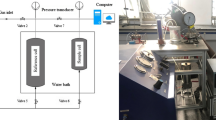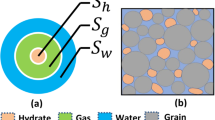Abstract
Pore bulk modulus in continuum apparent permeability models was generally treated as an independent parameter or deduced from the Betti-Maxwell reciprocal theorem neglecting the sorption effect, which is not appropriate for the unconventional reservoirs with strong gas sorption. In this work, pore bulk modulus was firstly derived from the Betti-Maxwell theorem with the consideration of the gas sorption strain and was incorporated into the solid–fluid coupling apparent permeability model. Numerical simulation was then conducted under the uniaxial strain condition and the stress confined condition to investigate the gas transport characteristics. The results showed that when taking into account for the sorption effect in the Betti-Maxwell theorem, the pore bulk modulus dramatically decreased with the falling pore pressure during the gas transport process under two loading conditions. Moreover, gas transport ability under the stress confined condition was greatly degraded while it was hardly changed under the uniaxial strain condition. Both the pore bulk modulus and the stress distribution in the reservoirs were found responsible for the variation of gas flow capacity. Finally, the effects of the parameters associated with the pore bulk modulus were examined to further discuss the impact of involving the sorption effect in the Betti-Maxwell theorem.













Similar content being viewed by others
Abbreviations
- α :
-
Biot's coefficient of the bulk medium
- α p :
-
Biot's coefficient of the pores
- β :
-
Dimensionless rarefaction coefficient
- C admax :
-
Maximum concentration of adsorbed gas
- D ad0 :
-
Surface diffusion coefficient
- E :
-
Young's modulus of the bulk medium
- ε ad :
-
Sorption strain of the bulk medium
- \(\varepsilon_{{{\text{ad}}}}^{{\text{p}}}\) :
-
Sorption strain of the pores
- ε L :
-
Langmuir volumetric strain
- ε :
-
Strain tensor
- ε v :
-
Volumetric strain of the bulk medium
- \(\varepsilon_{{\text{v}}}^{{\text{p}}}\) :
-
Volumetric strain of the pores
- η :
-
Ratio of the sorption strains
- f i :
-
Components of body force
- ϕ :
-
Pore porosity
- ϕ 0 :
-
Initial pore porosity
- J :
-
Gas mass flux per volume of bulk medium
- K :
-
Bulk modulus of the bulk medium
- K p :
-
Bulk modulus of the pores
- K s :
-
Bulk modulus of solid grain
- K n :
-
Knudsen number
- k app :
-
Apparent permeability
- \(k_{\infty }\) :
-
Intrinsic permeability
- \(k_{\infty 0}\) :
-
Initial intrinsic permeability
- M g :
-
Molar mass of gas molecules
- μ :
-
Gas viscosity
- ν :
-
Poisson's ratio of the bulk medium
- p :
-
Pore pressure
- p 0 :
-
Initial pore pressure
- p w :
-
Outer gas pressure on the boundary
- p c :
-
External confining stress
- P L :
-
Langmuir pressure constant
- Q 0 :
-
External gas resource
- R :
-
The universal gas constant
- ρ :
-
Gas mass per volume of bulk medium
- ρ g :
-
Gas density
- ρ ga :
-
Gas density under standard conditions
- ρ b :
-
Density of the bulk medium
- σ :
-
Stress tensor
- σ kk :
-
First stress invariant
- \(\overline{\sigma }\) :
-
Mean compressive stress
- T :
-
Temperature of the stratum
- τ h :
-
Tortuosity factor
- u i :
-
Components of displacement
- V :
-
Total volume
- V p :
-
Pore volume
- V L :
-
Langmuir volume constant
- ω bu :
-
Weight of free gas flow
- ω ad :
-
Weight of adsorbed gas flow
References
Beskok, A., Karniadakis, G.E.: A model for flows in channels, pipes, and ducts at micro and nanoscales. Microscale Thermophys. Eng. 3(1), 43–77 (1999)
Cao, P., Liu, J.S., Leong, Y.K.: Combined impact of flow regimes and effective stress on the evolution of shale apparent permeability. J. Unconv. Oil Gas Resour. 14, 32–43 (2016)
Chen, F.F., Duan, Y.G., Wang, K., Li, X.D., Liao, Y.: A novel pressure transient response model considering multiple migration mechanisms in shale gas reservoir. J. Nat. Gas Sci. Eng. 22, 321–334 (2015)
Cheng, A.H.D.: Poroelasticity. In: Hassanizadeh, S.M. (ed.) Theory and Applications of Transport in Porous Medium, vol. 27, p. 85. Springer, Berlin (2016)
Civan, F.: Effective correlation of apparent gas permeability in tight porous media. Transp. Porous Med. 82, 375–384 (2010)
Connell, L.D., Lu, M., Pan, Z.: An analytical coal permeability model for tri-axial strain and stress conditions. Int. J. Coal Geol. 84(2), 103–114 (2010)
Cui, X., Bustin, R.M.: Volumetric strain associated with methane desorption and its impact on coalbed gas production from deep coal seams. AAPG Bull. 89(9), 1181–1202 (2005)
Cui, G.L., Liu, J.S., Wei, M.Y., Shi, R., Elsworth, D.: Why shale permeability changes under variable effective stresses: New insights. Fuel 213, 55–71 (2018)
Davies, J.P., Davies, D.K.: Stress-dependent permeability: characterization and modeling. SPE J. 6(2), 224–235 (2001)
Deng, J., Zhu, W.Y., Ma, Q.: A new seepage model for shale gas reservoir and productivity analysis of fractured well. Fuel 124, 232–240 (2014)
Dong, J.J., Hsu, J.Y., Wu, W.J., Shimamoto, T., Hung, J.H., Yeh, E.C., Sone, H.: Stress-dependence of the permeability and porosity of sandstone and shale from TCDP hole-A. Int. J. Rock Mech. Min. Sci. 47(7), 1141–1157 (2010)
Feng, X.L., Ma, F.S., Zhao, H.J., Liu, G., Guo, J.: Gas multiple flow mechanisms and apparent permeability evaluation in shale reservoirs. Sustainability 11, 2114 (2019)
Gensterblum, Y., Ghanizadeh, A., Cuss, R.J., Amann-Hildenbrand, A., Krooss, B.M., Clarkson, C.R., Harrington, J.F., Zoback, M.D.: Gas transport and storage capacity in shale gas reservoirs—a review. Part A: Transport processes. J. Unconv. Oil Gas Resour. 12, 87–122 (2015)
Guo, P.K., Cheng, Y.P., Jin, K., Li, W., Tu, Q.Y., Liu, H.Y.: Impact of effective stress and matrix deformation on the coal fracture permeability. Transp. Porous Med. 103, 99–115 (2014)
Huang, T., Tao, Z.W., Li, E.P., Lyu, Q.Q., Guo, X.: Effect of permeability anisotropy on the production of multi-scale shale gas reservoirs. Energies 10, 1549 (2017)
Javadpour, F.: Nanopores and apparent permeability of gas flow in mudrocks (shales and siltstone). J. Can. Pet. Technol. 48(8), 16–21 (2009)
Jiang, C.Z., Zhao, Z.F., Zhang, X.W., Liu, J.S., Elsworth, D., Cui, G.L.: Controlling effects of differential swelling index on evolution of coal permeability. J. Rock Mech. Geotech. Eng. (2020). https://doi.org/10.1016/j.jrmge.2020.02.001
Liu, H.H., Rutqvist, J.: A new coal-permeability model: internal swelling stress and fracture–matrix interaction. Transp. Porous Med. 82, 157–171 (2010)
Liu, J.S., Chen, Z.W., Elsworth, D., Qu, H.Y., Chen, D.: Interactions of multiple processes during CBM extraction: a critical review. Int. J. Coal Geol. 87, 175–189 (2011a)
Liu, J.S., Chen, Z.W., Elsworth, D., Miao, X.X., Mao, X.B.: Evolution of coal permeability from stress-controlled to displacement-controlled swelling conditions. Fuel 90, 2987–2997 (2011b)
Lu, S.Q., Cheng, Y.P., Li, W.: Model development and analysis of the evolution of coal permeability under different boundary conditions. J. Nat. Gas Sci. Eng. 31, 129–138 (2016)
Medved, I., Cerny, R.: Surface diffusion in porous media: A critical review. Microporous Mesoporous Mater. 142, 405–422 (2011)
Ng, E.Y., Liu, N.: A multicoefficient slip-corrected Reynolds equation for micro-thin film gas Lubrication. Int. J. Rotating Mach. 2, 105–111 (2005)
Palmer, I., Mansoori, J.: How permeability depends on stress and pore pressure in coalbeds: a new model. SPE Reserv. Eval. Eng. 1(6), 539–544 (1998)
Pan, Z., Connell, L.D.: A theoretical model for gas adsorption-induced coal swelling. Int. J. Coal Geol. 69(4), 243–252 (2007)
Robertson, E.P., Christiansen, R.L.: A permeability model for coal and other fractured sorptive-elastic media. SPE J. 13(3), 314–324 (2006)
Sheng, G., Javadpour, F., Su, Y.L.: Effect of microscale compressibility on apparent porosity and permeability in shale gas reservoirs. Int. J. Heat Mass Transf. 120, 56–65 (2018)
Shi, J.Q., Durucan, S.: A model for changes in coalbed permeability during primary and enhanced methane recovery. SPE Reserv. Eval. Eng. 8(4), 291–299 (2005)
Song, W.H., Yao, J., Li, Y., Sun, H., Zhang, L.J., Yang, Y.F., Zhao, J.L., Sui, H.G.: Apparent gas permeability in an organic-rich shale reservoir. Fuel 181, 973–984 (2016)
Song, W.H., Yao, J., Li, Y., Sun, H., Yang, Y.F.: Fractal models for gas slippage factor in porous media considering second-order slip and surface adsorption. Int. J. Heat Mass Transf. 118, 948–960 (2018)
Sun, Z., Li, X.F., Shi, J.T., Zhang, T., Sun, F.R.: Apparent permeability model for real gas transport through shale gas reservoirs considering water distribution characteristic. Int. J. Heat Mass Transf. 115, 1008–1019 (2017)
Wang, W., Yao, J., Sun, H., Song, W.H.: Influence of gas transport mechanisms on the productivity of multi-stage fractured horizontal wells in shale gas reservoirs. Pet. Sci. 12, 664–673 (2015)
Wang, J., Luo, H., Liu, H.: An integrative model to simulate gas transport and production coupled with gas adsorption, non-Darcy flow, surface diffusion, and stress dependence in organic-shale reservoirs. SPE J. 22, 244–264 (2017)
Wang, K., Wang, G., Jiang, Y.J., Wang, S., Han, W., Chen, X.G.: How transport properties of a shale gas reservoir change during extraction: A strain-dependent triple-porosity model. J. Pet. Sci. Eng. 180, 1088–1100 (2019a)
Wang, C., Zang, Y., Wang, L., Chen, Z., Cui, G., Fan, K., Liu, W.: Interaction of cleat-matrix on coal permeability from experimental observations and numerical analysis. Geofluids (2019b). https://doi.org/10.1155/2019/7474587
Wu, K.L., Li, X.F., Chen, Z.X., Li, J.J., Hu, Y., Jiang, L.L.: Gas transport behavior through micro fractures of shale and tight gas reservoirs (in Chinese). Chin. J. Theor. Appl. Mech. 47(6), 955–964 (2015a)
Wu, K.L., Li, X.F., Chen, Z.X.: The mechanism and mathematical model for the adsorbed gas surface diffusion in nanopores of shale gas reservoirs (in Chinese). Sci. China Technol. Sci. 45, 525–540 (2015b)
Wu, K.L., Li, X.F., Guo, C.H., Wang, C., Chen, Z.X.: A unified model for gas transfer in nanopores of shale-gas reservoirs: coupling pore diffusion and surface diffusion. SPE J. 21(5), 1583–1611 (2016a)
Wu, K.L., Chen, Z.X., Li, X.F., Guo, C.H., Wei, M.Z.: A model for multiple transport mechanisms through nanopores of shale gas reservoirs with real gas effect-adsorption-mechanic coupling. Int. J. Heat Mass Transf. 93, 408–426 (2016b)
Yang, X., Zhang, H.B., Wu, W.B., Gong, Z.H., Yuan, W.F., Feng, X.Q., Gu, B.: Gas migration in the reservoirs of ultra-low porosity and permeability based on an improved apparent permeability model. J. Petrol. Sci. Eng. 185, 106614 (2020)
Yu, H., Chen, J., Zhu, Y.B., Wang, F.C., Wu, H.A.: Multiscale transport mechanism of shale gas in micro/nano-pores. Int. J. Heat Mass Transf. 111, 1172–1180 (2017)
Zhang, H.B., Liu, J.S., Elsworth, D.: How sorption-induced matrix deformation affects gas flow in coal seams: a new FE model. Int. J. Rock Mech. Min. Sci. 45(8), 1226–1236 (2008)
Zhang, L.J., Li, D.L., Lu, D.T., Zhang, T.: A new formulation of apparent permeability for gas transport in shale. J. Nat. Gas Sci. Eng. 23, 221–226 (2015a)
Zhang, M., Yao, J., Sun, H., Zhao, J.L., Fan, D.Y., Huang, Z.Q., Wang, Y.Y.: Triple-continuum modeling of shale gas reservoirs considering the effect of kerogen. J. Nat. Gas Sci. Eng. 24, 252–263 (2015b)
Zhang, Q., Yan, X., Shao, J.L.: Fluid flow through anisotropic and deformable double porosity media with ultra-low matrix permeability: a continuum framework (2021). arXxiv:2002.08180v11 [physics.geo-ph], https://doi.org/10.1016/j.petrol.2021.108349.
Acknowledgements
The authors would like to thank the financial supports from the National Natural Science Foundation of China (Grant No. 11872324) and Education Department of Sichuan Province of China (Grant No. 18ZA0491).
Author information
Authors and Affiliations
Corresponding authors
Ethics declarations
Conflict of interest
The authors declare that they have no conflict of interest.
Additional information
Publisher's Note
Springer Nature remains neutral with regard to jurisdictional claims in published maps and institutional affiliations.
Rights and permissions
About this article
Cite this article
Ying, Q., Zhang, H., Zhao, J. et al. Influence of Considering the Sorption Effect in the Betti-Maxwell Reciprocal Theorem on Gas Transport Capacity in Unconventional Reservoirs. Transp Porous Med 137, 451–469 (2021). https://doi.org/10.1007/s11242-021-01565-7
Received:
Accepted:
Published:
Issue Date:
DOI: https://doi.org/10.1007/s11242-021-01565-7




